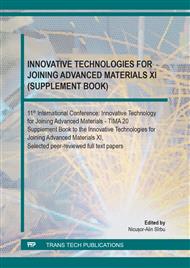p.3
p.9
p.17
p.25
p.35
p.47
p.55
p.67
Preliminary Research for Development of MW-TIG Hybrid Welding System
Abstract:
The paper aims to report preliminary researches towards to development of new hybrid welding system by coupling a microwave beam with a TIG torch. The main research was focused on the designing of hybrid system as well as to establish the heating/welding mechanism by coupling two different thermal sources. Therefore, a specific welding chamber was designed taking into consideration the limitations provided by microwave waveguide technical specs, geometrical shape and dimensions of the TIG torch as well as the temperature monitoring during welding process and video surveillance for data recording. A microwave generator with adjustable power from 0 to 1250 W was coupled with a TIG torch and welding power source in order to establish the main parameters for hybrid system. The preliminary researches reported that the MW-TIG hybrid welding could be applied to eutectic joining of materials using low power (up to 600 W) injected from microwave generator as well as low welding current (up to 20 A). The flow of shielding gas have been established initially to 2 l/m. The research related to stabilization of MW-WIG plasma arc have been studied by increasing the flow of shielding gas up to 10 l/m. The results have shown that the microwave generator and TIG torch can be coupled to obtain hybrid-welding process without any matching tuning devices but with risks for damaging the microwave generator. Further researches will be done in order to design auxiliary devices to optimize the hybrid-welding process and to avoid any unwanted plasma arc discharge from welded base materials to microwave generator. In terms of temperature monitoring, an infrared pyrometer has been used. The IR pyrometer was targeted to the base materials in order to be able to measure their temperature without any influences from plasma arc. The results obtained have shown a stable plasma at average microwave power around 400 W even without any TIG current.
Info:
Periodical:
Pages:
9-15
Citation:
Online since:
June 2021
Keywords:
Price:
Сopyright:
© 2021 Trans Tech Publications Ltd. All Rights Reserved
Share:
Citation:


